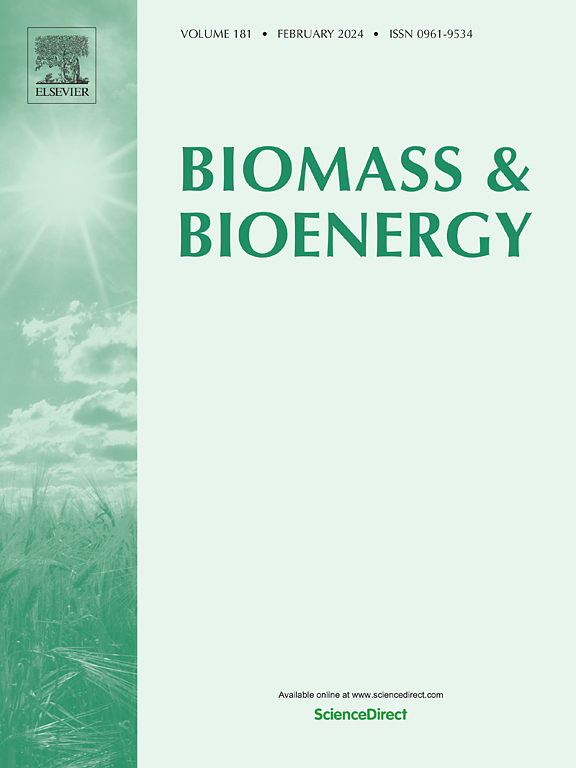Tree-level biomass estimation using unmanned aerial vehicle (UAV) imagery and allometric equation
IF 5.8
2区 生物学
Q1 AGRICULTURAL ENGINEERING
引用次数: 0
Abstract
Estimating forest biomass is imperative for comprehensively understanding the function of forest in regulating climate, providing theoretical support for vegetation management. Constructing allometric equations rationally is essential for accurate tree-level biomass estimation without destructive sampling, and optimizing the sample size for fitting allometric equations ensures a desirable balance between accuracy and cost. In this study, the optimal sample size and the best allometric equation for biomass estimation were discussed using unmanned aerial vehicles (UAVs) imagery and field measurements of tree height (H), diameter at breast height (DBH) and crown radius (Rc) in an artificial Pinus tabuliformis forest. Results demonstrated that the optimal sample size for accurately estimating tree-level biomass with minimal manpower and time costs was 130. Besides, the estimating precision of allometric equations can be enhanced by increasing the number of suitable variables, altering the variables combination, and modifying functional forms. The proposed allometric equation based on H and Rc in this study outperformed common equations in estimating Pinus tabuliformis forest biomass. This equation achieved a coefficient of determination (R2) of 0.72 and a root-mean-square error (RMSE) of 8.56 kg for biomass estimation, owing to its utilization of multivariate analysis and exclusive application of logarithmic transformation to the dependent variable. Moreover, the study revealed that the total biomass of 1490 planted Pinus tabuliformis trees in this study area was 67.3 t. This research offers valuable insights into accurately estimating tree-level forest biomass, which is essential for addressing challenging ecological issues and formulating rational forest management policies.
利用无人飞行器(UAV)图像和异速方程估算树木生物量
要全面了解森林调节气候的功能,为植被管理提供理论支持,就必须估算森林生物量。在不进行破坏性采样的情况下,合理构建异速方程对准确估算树体生物量至关重要,而优化拟合异速方程的样本量可确保在精度和成本之间取得理想的平衡。在本研究中,利用无人机(UAVs)图像和对人工赤松林中树高(H)、胸径(DBH)和树冠半径(Rc)的实地测量,讨论了生物量估算的最佳样本量和最佳异速方程。结果表明,以最小的人力和时间成本准确估算树体生物量的最佳样本量为 130 个。此外,还可以通过增加合适变量的数量、改变变量组合和修改函数形式来提高异速方程的估算精度。本研究提出的基于 H 和 Rc 的异速方程在估算赤松森林生物量方面优于普通方程。由于该方程采用了多元分析并对因变量进行了对数变换,其生物量估算的判定系数(R2)为 0.72,均方根误差(RMSE)为 8.56 千克。这项研究为准确估算树级森林生物量提供了宝贵的见解,这对于解决具有挑战性的生态问题和制定合理的森林管理政策至关重要。
本文章由计算机程序翻译,如有差异,请以英文原文为准。
求助全文
约1分钟内获得全文
求助全文
来源期刊

Biomass & Bioenergy
工程技术-能源与燃料
CiteScore
11.50
自引率
3.30%
发文量
258
审稿时长
60 days
期刊介绍:
Biomass & Bioenergy is an international journal publishing original research papers and short communications, review articles and case studies on biological resources, chemical and biological processes, and biomass products for new renewable sources of energy and materials.
The scope of the journal extends to the environmental, management and economic aspects of biomass and bioenergy.
Key areas covered by the journal:
• Biomass: sources, energy crop production processes, genetic improvements, composition. Please note that research on these biomass subjects must be linked directly to bioenergy generation.
• Biological Residues: residues/rests from agricultural production, forestry and plantations (palm, sugar etc), processing industries, and municipal sources (MSW). Papers on the use of biomass residues through innovative processes/technological novelty and/or consideration of feedstock/system sustainability (or unsustainability) are welcomed. However waste treatment processes and pollution control or mitigation which are only tangentially related to bioenergy are not in the scope of the journal, as they are more suited to publications in the environmental arena. Papers that describe conventional waste streams (ie well described in existing literature) that do not empirically address ''new'' added value from the process are not suitable for submission to the journal.
• Bioenergy Processes: fermentations, thermochemical conversions, liquid and gaseous fuels, and petrochemical substitutes
• Bioenergy Utilization: direct combustion, gasification, electricity production, chemical processes, and by-product remediation
• Biomass and the Environment: carbon cycle, the net energy efficiency of bioenergy systems, assessment of sustainability, and biodiversity issues.
 求助内容:
求助内容: 应助结果提醒方式:
应助结果提醒方式:


